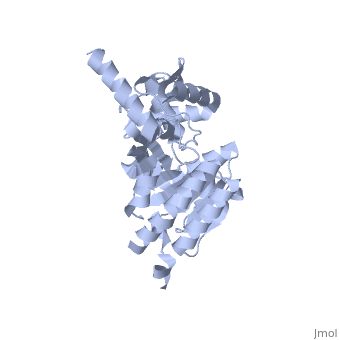Function
Recombinase A (RecA), a naturally aggregating protein involved in DNA repair, is an important asset to the genetic integrity of the Escherichia coli (E. coli) genome.[1] The survival of all species rely on such DNA repair processes. RecA homologues are found in all kingdoms including archaebacteria, eubacteria, and eukaryotes.[2] Rad51, for example, is a RecA homologue found specifically in humans.[3] An over-expression of Rad51 in the nuclei of tumor cells when compared to those of normal breast tissue has been linked to sporadic, non-hereditary, breast cancers.[4] See also Isomerases, DNA Repair.
DNA Repair
In E. coli, RecA’s central function involves strand exchange, specifically recombinational DNA repair.[5] The DNA recombination mechanism for RecA is a process that results in the exchange of strands between two homologous DNA molecules.[6] The DNA that results from this process is a nicked circular dsDNA molecule and one or two linear ssDNA molecules, depending on the number of DNA strands involved (three or four).[5] [6] During DNA strand exchange, adenosine triphosphate (ATP) is hydrolyzed to form adenosine diphosphate (ADP) and inorganic phosphate (Pi). ATP hydrolysis is required for DNA strand exchange to be unidirectional (without ATP hydrolysis, strand exchange is also bidirectional), for the circumvention of various structural obstacles on the DNA molecule such as heterologous inserts, and for DNA strand exchange to occur with four stands of DNA.[1] [5]
Other RecA Functions
RecA is also involved in inducing the SOS response to DNA damage by assisting in the cleavage, and consequent inactivation, of proteins.[5] Examples of such proteins are the LexA repressor and the λ repressor.[5]
Binding Sites on RecA
As RecA has many different functions, it also has several different (ADP in Orange/Red and Mg ion in lime green) for DNA, ADP, ATP, the LexA repressor, the λ repressor, as well as other RecA protein monomers to form a variety of oligomers.[5] [7] [8] The (single-stranded DNA colored purple, ATP colored magenta, and Aluminum tetrafluoride colored lime green) consists of six RecA monomers per turn of the helix, and each individual monomer is capable of binding three base pairs of the extended conformation of DNA.[9] This filament is not the only oligomer of RecA that exists in solution, however. Sattin and Goh have reported a variety of RecA structures in buffer, such as monomers, hexamers, rods/fibrils, protofibrils, and other small aggregates.[10] Moreover, the type and amount of these different aggregation states is dynamic. Brenner and Zlotnick reported that the presence of monovalent salts changed the distribution of RecA aggregation states and that higher protein concentration tended to correspond to more aggregated structures.[11] ATP hydrolysis occurs in the region of a loop consisting of amino acids 66-73 of the protein, which corresponds to the Walker A box motif and has the sequence GPESSGKT.[5] [7] This sequence corresponds to a variation known as the (phosphate ion shown in Red/Orange), which has a sequence [G/A]XXXXGK[T/S] found in many nucleoside triphosphate (NTP)-binding proteins.[7] [8] Several of the residues in this phosphate binding loop can be seen interacting with the β and γ phosphates of ATP in the ATP-binding site proposed by Story and Steitz.[7] The binding of various ligands to RecA has been shown to change the pitch, the “distance covered by each turn of the helix,” of the protein filament.[12] [13] RecA in the absence of any cofactor is in a “closed” conformation with a helical pitch of 7 nm (DNA binding to the RecA does not alter the pitch significantly). (ATP shown in Red/Organge) increases the pitch to 9 nm.[12] This RecA-ATP structure is marked by a higher affinity for DNA.[5] [13] However, the (ADP in Red/Orange) only raises the pitch to 8.2 nm,[12] the conformation of which is known to have a lower affinity for DNA.[5] [13]
RecA and Hofmeister Salts
High salt concentrations have also been shown to be able to elongate the RecA protein filament as well. Petukhov et al. demonstrated that a high concentration of NaCl increased the helical pitch from 7.8 to 8.6 nm.[14] Thus, high salt concentrations appear to induce the active (stretched) form of RecA in the absence of DNA.[14] Other studies have found that the free Magnesium ion binds to RecA (see ; Mg ion is colored lime green) and extends the filament more than 150% compared to the filament when DNA is bound.[15] Moreover, although normally RecA requires DNA to hydrolyze ATP, high salt concentrations are able to stimulate ATP hydrolysis in the absence of DNA.[16] Brenner and Zlotnick reported that the presence of monovalent salts changed the distribution of RecA aggregation states and that the more aggregated structures corresponded to higher protein concentration.[11] Previous studies have shown that various Hofmeister salts affect the secondary structure, stability, and aggregation behavior of RecA differently.[11] [17] Additionally, RecA has been demonstrated to follow the inverse-anionic Hofmeister series and the presence of some ions promotes nonspecific aggregation.[17]
3D structures of recombinase A
3D structures of recombinase A

